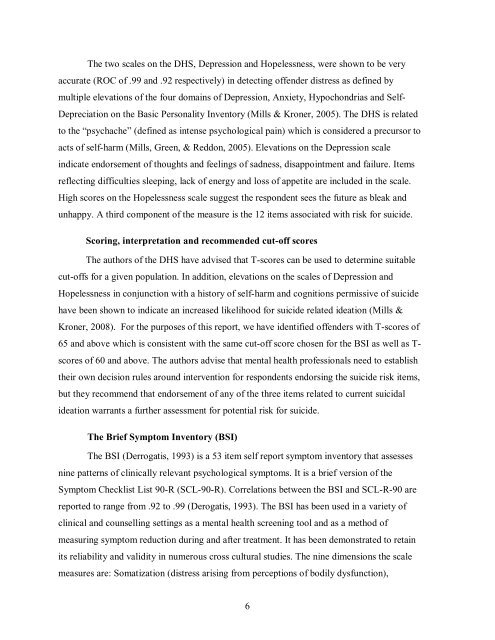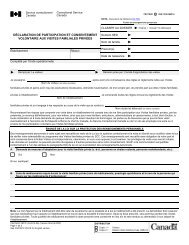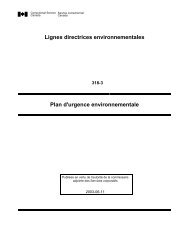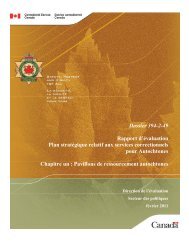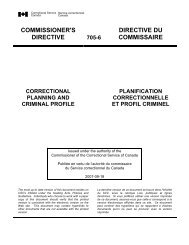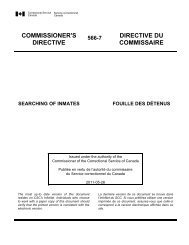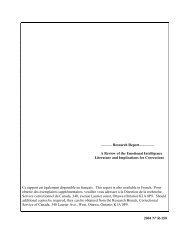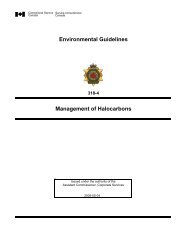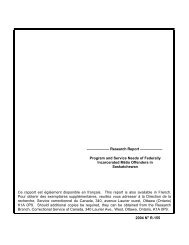The Brief Symptom Inventory (BSI) - Service correctionnel du Canada
The Brief Symptom Inventory (BSI) - Service correctionnel du Canada
The Brief Symptom Inventory (BSI) - Service correctionnel du Canada
You also want an ePaper? Increase the reach of your titles
YUMPU automatically turns print PDFs into web optimized ePapers that Google loves.
<strong>The</strong> two scales on the DHS, Depression and Hopelessness, were shown to be very<br />
accurate (ROC of .99 and .92 respectively) in detecting offender distress as defined by<br />
multiple elevations of the four domains of Depression, Anxiety, Hypochondrias and Self-<br />
Depreciation on the Basic Personality <strong>Inventory</strong> (Mills & Kroner, 2005). <strong>The</strong> DHS is related<br />
to the “psychache” (defined as intense psychological pain) which is considered a precursor to<br />
acts of self-harm (Mills, Green, & Reddon, 2005). Elevations on the Depression scale<br />
indicate endorsement of thoughts and feelings of sadness, disappointment and failure. Items<br />
reflecting difficulties sleeping, lack of energy and loss of appetite are included in the scale.<br />
High scores on the Hopelessness scale suggest the respondent sees the future as bleak and<br />
unhappy. A third component of the measure is the 12 items associated with risk for suicide.<br />
Scoring, interpretation and recommended cut-off scores<br />
<strong>The</strong> authors of the DHS have advised that T-scores can be used to determine suitable<br />
cut-offs for a given population. In addition, elevations on the scales of Depression and<br />
Hopelessness in conjunction with a history of self-harm and cognitions permissive of suicide<br />
have been shown to indicate an increased likelihood for suicide related ideation (Mills &<br />
Kroner, 2008). For the purposes of this report, we have identified offenders with T-scores of<br />
65 and above which is consistent with the same cut-off score chosen for the <strong>BSI</strong> as well as T-<br />
scores of 60 and above. <strong>The</strong> authors advise that mental health professionals need to establish<br />
their own decision rules around intervention for respondents endorsing the suicide risk items,<br />
but they recommend that endorsement of any of the three items related to current suicidal<br />
ideation warrants a further assessment for potential risk for suicide.<br />
<strong>The</strong> <strong>Brief</strong> <strong>Symptom</strong> <strong>Inventory</strong> (<strong>BSI</strong>)<br />
<strong>The</strong> <strong>BSI</strong> (Derrogatis, 1993) is a 53 item self report symptom inventory that assesses<br />
nine patterns of clinically relevant psychological symptoms. It is a brief version of the<br />
<strong>Symptom</strong> Checklist List 90-R (SCL-90-R). Correlations between the <strong>BSI</strong> and SCL-R-90 are<br />
reported to range from .92 to .99 (Derogatis, 1993). <strong>The</strong> <strong>BSI</strong> has been used in a variety of<br />
clinical and counselling settings as a mental health screening tool and as a method of<br />
measuring symptom re<strong>du</strong>ction <strong>du</strong>ring and after treatment. It has been demonstrated to retain<br />
its reliability and validity in numerous cross cultural studies. <strong>The</strong> nine dimensions the scale<br />
measures are: Somatization (distress arising from perceptions of bodily dysfunction),<br />
6


